Table of Contents
Chitraka
Plumbago zeylanica Linn – Ayurvedic Herb

Literary review
- It is forbidden leafy vegetable. [vaikhanasa sutra 3/5/8]
- Charaka described it as the best drug to cure guda roga, arshas and shoola.[Ch.Su.25]
- In the contest of Rasayana Sushruta advocated the utility of chitraka rasayana similar to that of bakuchi rasayana.
- Vaghbhata delineated three varieties of Chitraka and quoted them for rasayana purpose.
- In Lolambarariyam(sadvaidyajivanam) Chitraka is indicated as the best vehicle in case of arshas
- Charaka used the terms chitra- Chitraka together under Bhedaniya dashaimani.
- Some scholars are the opinion that charaka erroneously enumerated Chitraka under bhedaniya group since it is also mentioned as the example for prabhava while comprising it with danthi.
- Chitra- Chitraka in this context may be Danti- Dravanti according to author.
- Otherwise Chitraka described here may be a variety of eranda (as charaka mentioned two types of eranda)
- Present research reveals that plumbagin obtained of Plumbago zeylanica is a potent cytotoxic or anti cancer agent.
- Rajanarahari described raktachitraka for parada niyamana and loha vedhana.
- This variety of Chitraka is claimed to be useful to gain weight and strength for the human body.
- Chitraka is the one of the main ingredient in thrimada, panchakola and shadooshana.
Synonyms
Chitraka- Shows teevragati action against gulmadi diseases.
Anala nama-Known by agni nama or hotness is agni tulya and also veerya and sparsha is ushna.
Dahanam
Peetina- Dangerous or poisonous to fishes.
Vahni
Vyala- Causes blister or injury like vyala.
Agni
Jarana – Which helps in digestion of food.
Jyothi
Hutasana
Shikhi
Paali
Aruna
Dvipi- Fast action like leapord.
Paavaka
Paati
Jyitishkashaardoola
Daaruna- Which isdangerous.
Deepaka – Agni daapaka.
Peeti- Which cures grahani, kushta.
BHEDA
Vaghbhata quoted three varieties of Chitraka
- Shwetha
- Peeta
- Asita.
Raja nighantu the second variety of Chitraka i,e Rakta Chitraka is denoted as Kalaha.
Posology and vishishta yoga
Choorna- 1-2 gm
Kwatha- 25-50 ml
Higher dose causes burning sensation and intoxication
Chitrakadi vati.
Chitrakaharitaki [Vr.ma.60/26-28]
Chitrakadi ghrita. [Ch.Da 4/43]
Chitraka rasayana. [A.H.3/39/62-65]
Agnitundi vati.
Chitrakadi choorna. [ch.chi.12/58-59,
Chitraka Kashaya. [Su.chi.11/9]
Shaddharana yoga.[Su.chi.4/2]
Useful part
Moola twak (Root bark)
Chemical composition
Root contains a bitter , crystalline, yellow, active substance known as Plumbagin (0.91%), also
- Chitranone,
- Plumbagic acid,
- 3-Chloroplumbagin,
- Droserone.
Karma
- Agnideepaka
- Paacaka
- Grahi
- Kushataghna
- Shothaghna
- Krimighna
- Kasaghna
- Garbhashaya sankochaka
- Sveda janana
- Rasayana
- Lekhana
- Visphota janana
- Garbha sravaka
- Jwaraghna.
Uses
Gulma,
grhini,
mandagni.
Kapha shoosha,
vatodara,
arshas,
grhini,
kshaya,
pandu,
mandaghnni
Grahini,
kapha
vatam,
shopha,
kushta,
udara,
krimi,
mandaghni,
Mandhagni,
Action and toxicity
The chitrka is an antimicrobic, appetizer, paacaka, grahi, kushtaghna, shothaghna, krimighna, kasaghna, garbhashaya sankochaka, sveda janana, rasayana, lekhana, jwaraghna.
It is used in pandu, grahani, arshas, udara, kushta, kasa ,shwasa, shotha, agnimandya, jwara, vedanayukta vata vikara.
Toxicity
On excessive dose causes daha in gala, amashaya and all over body, followed by chardi, atisara, mutra kruchra, naadi kshina.
It is contraindicated in Progency.
Antidote
Pittashamaka , snighda, and sheeta preparations should be given. Ex: Kshiraand chandana.
Therapeutic uses
Grhani- Chitrakadya gutika and Chitraka ghrita.
[ch.ci.15/96-97]
Arshas- kalka of Chitraka mixed with shunti and sour gruel is applied to haemorrhoids. [Ch.Chi. 14/68]
Twak of Chitraka is made in to kalka and in the same vessel , it curdled or buttermilk is prepared, on intake destroys piles.
[Ch.Chi.14/76,Su.Chi.6/13]
Pandu –Bala moola and Chitraka 10 gmis to be taken with warm water or shigru beeja mixed with equal salt keeping on milk diet. [Su.Ut.44/26]
Udara roga- Chitraka ghrita is taken. [Ch.Chi.13/116]
Shotha – Regular local application of the warm paste of Chitraka and devadaru or sarshapa and shigru pounded with gomootra is useful. [Vr.Ma.42/5]
Research work
- Plant extract (100 mg/kg 0 prevented100%ovulation and implantation in female rats.
- Plumbagin exhibited specific antimicrobial activity against yeasts and potent insect antifeedant activity against larva of African army worms.
- Plumbagin administered intratumorally and orally at 2mg/kg decreased tumour growth by 70 % and 605 respactively in rats with methylcholanthrene induced tumours.
- Plumbagin was active against P388 lymphocyticluekamiaat 4 mg/kg and showed antibacterial and antifungal activity against a wide variety of bacteria and fungus.
- Topical application of plumbagin has been found to be useful in patients with common work.
Cultivation and harvesting
Plumbago looses its leaves in the winter and is rather late to come back the next spring, so be careful when cultivating.
ATTRIBUTES
- Specimen
- Drought tolerant
- Erosion control
- Container
- Dwarf plant
ECOLOGY
Exposure : Sun
Season of interest (Foliage)
Summer flowers
Late spring or early summer
Late summer
Fall flowers.
Soil : Clay, salt, loam.
Soil moisture needs :
Average
Well drained
Dry moist
Substitutes and adulteration
Root and root bark of Plumbago rosea Linn is considered to be more potent therapeutically. These roots are comparatively thin and dark brown to black in colour . The availability of the drug is however, low due to its restricted natural distribution in India.
